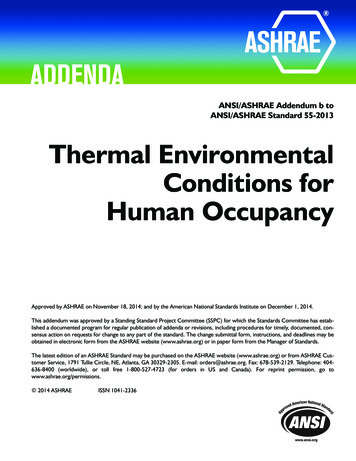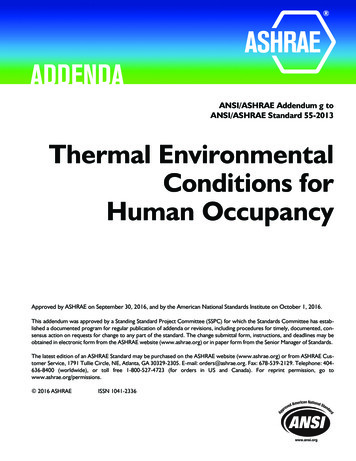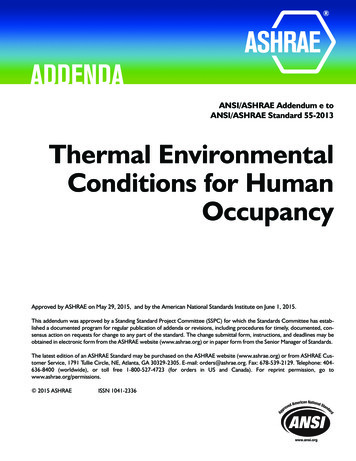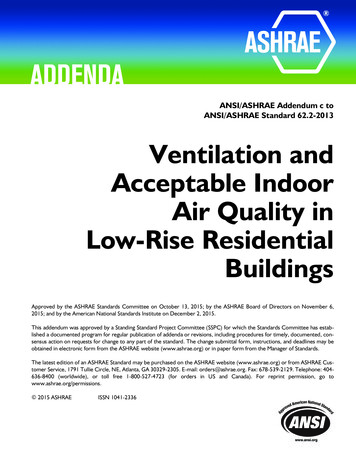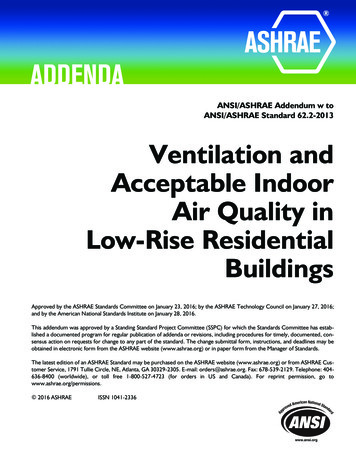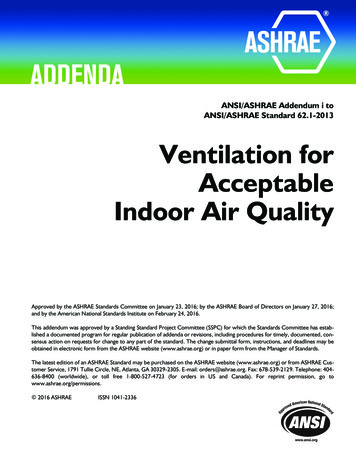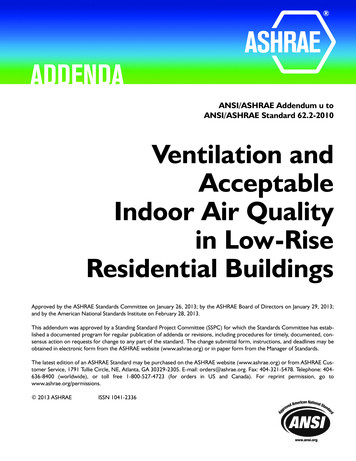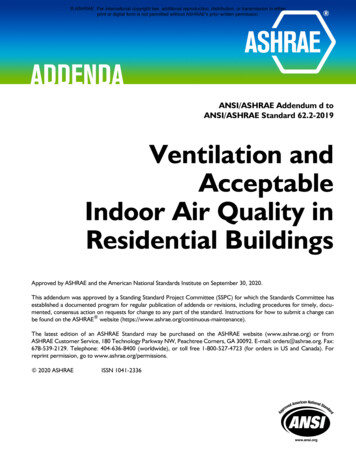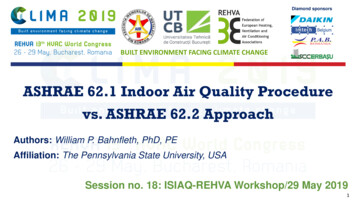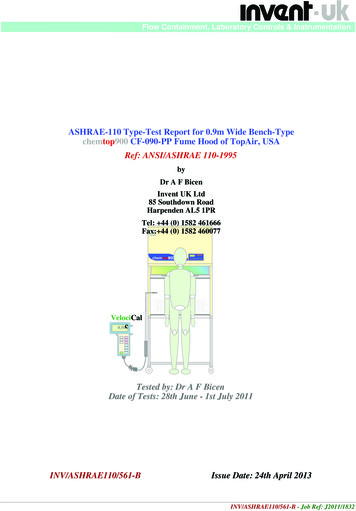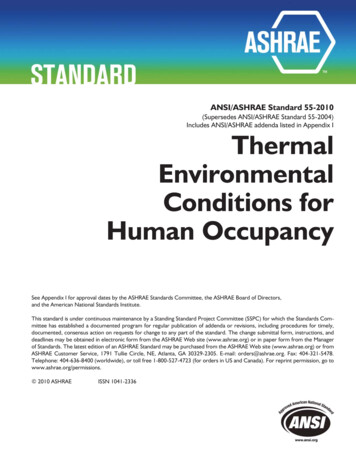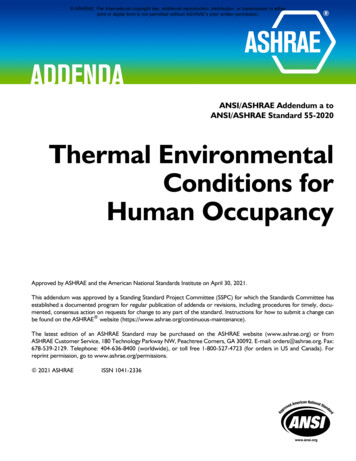
Transcription
ASHRAE. Per international copyright law, additional reproduction, distribution, or transmission in eitherprint or digital form is not permitted without ASHRAE's prior written permission.ANSI/ASHRAE Addendum a toANSI/ASHRAE Standard 55-2020Thermal EnvironmentalConditions forHuman OccupancyApproved by ASHRAE and the American National Standards Institute on April 30, 2021.This addendum was approved by a Standing Standard Project Committee (SSPC) for which the Standards Committee hasestablished a documented program for regular publication of addenda or revisions, including procedures for timely, documented, consensus action on requests for change to any part of the standard. Instructions for how to submit a change canbe found on the ASHRAE website e latest edition of an ASHRAE Standard may be purchased on the ASHRAE website (www.ashrae.org) or fromASHRAE Customer Service, 180 Technology Parkway NW, Peachtree Corners, GA 30092. E-mail: orders@ashrae.org. Fax:678-539-2129. Telephone: 404-636-8400 (worldwide), or toll free 1-800-527-4723 (for orders in US and Canada). Forreprint permission, go to www.ashrae.org/permissions. 2021 ASHRAEISSN 1041-2336
ASHRAE. Per international copyright law, additional reproduction, distribution, or transmission in eitherprint or digital form is not permitted without ASHRAE's prior written permission.ASHRAE Standing Standard Project Committee 55Cognizant TC: 2.1, Physiology and Human EnvironmentSPLS Liaison: Karl L. PetermanDavid Heinzerling*, Chair and WebmasterJosh Eddy, SecretaryPeter F. Alspach*Sama AghniaeyEdward A. Arens*Robert Bean*Essam E. Khalil*Baizhan Li*Rodrigo Mora*Gwelen PaliagaZaccary A. Poots*David M. Rose*Lawrence J. Schoen*Peter SimmondsAaron R. SmithJohn G. Williams** Denotes members of voting status when the document was approved for publicationASHRAE STANDARDS COMMITTEE 2020–2021Drury B. Crawley, ChairRick M. Heiden, Vice ChairEls BaertCharles S. BarnabyRobert B. BurkheadThomas E. CappellinDouglas D. FickWalter T. GrondzikSusanna S. HansonJonathan HumbleSrinivas KatipamulaGerald J. KettlerEssam E. KhalilMalcolm D. KnightJay A. KohlerLarry KoumaCesar L. LimJames D. LutzKarl L. PetermanErick A. PhelpsDavid RobinLawrence J. SchoenSteven C. SillRichard T. SwierczynaChristian R. TaberRussell C. TharpTheresa A. WestonCraig P. WrayJaap Hogeling, BOD ExOWilliam F. McQuade, COConnor Barbaree, Senior Manager of StandardsSPECIAL NOTEThis American National Standard (ANS) is a national voluntary consensus Standard developed under the auspices of ASHRAE. Consensus is definedby the American National Standards Institute (ANSI), of which ASHRAE is a member and which has approved this Standard as an ANS, as“substantial agreement reached by directly and materially affected interest categories. This signifies the concurrence of more than a simple majority,but not necessarily unanimity. Consensus requires that all views and objections be considered, and that an effort be made toward their resolution.”Compliance with this Standard is voluntary until and unless a legal jurisdiction makes compliance mandatory through legislation.ASHRAE obtains consensus through participation of its national and international members, associated societies, and public review.ASHRAE Standards are prepared by a Project Committee appointed specifically for the purpose of writing the Standard. The ProjectCommittee Chair and Vice-Chair must be members of ASHRAE; while other committee members may or may not be ASHRAE members, allmust be technically qualified in the subject area of the Standard. Every effort is made to balance the concerned interests on all Project Committees.The Senior Manager of Standards of ASHRAE should be contacted fora. interpretation of the contents of this Standard,b. participation in the next review of the Standard,c. offering constructive criticism for improving the Standard, ord. permission to reprint portions of the Standard.DISCLAIMERASHRAE uses its best efforts to promulgate Standards and Guidelines for the benefit of the public in light of available information and acceptedindustry practices. However, ASHRAE does not guarantee, certify, or assure the safety or performance of any products, components, or systemstested, installed, or operated in accordance with ASHRAE’s Standards or Guidelines or that any tests conducted under its Standards or Guidelineswill be nonhazardous or free from risk.ASHRAE INDUSTRIAL ADVERTISING POLICY ON STANDARDSASHRAE Standards and Guidelines are established to assist industry and the public by offering a uniform method of testing for rating purposes, bysuggesting safe practices in designing and installing equipment, by providing proper definitions of this equipment, and by providing other informationthat may serve to guide the industry. The creation of ASHRAE Standards and Guidelines is determined by the need for them, and conformanceto them is completely voluntary.In referring to this Standard or Guideline and in marking of equipment and in advertising, no claim shall be made, either stated or implied,that the product has been approved by ASHRAE.ASHRAE is a registered trademark of the American Society of Heating, Refrigerating and Air-Conditioning Engineers, Inc.ANSI is a registered trademark of the American National Standards Institute.
ASHRAE. Per international copyright law, additional reproduction, distribution, or transmission in eitherprint or digital form is not permitted without ASHRAE's prior written permission.(This foreword is not part of this standard. It is merely informative and does not containrequirements necessary for conformance to the standard. It has not been processedaccording to the ANSI requirements for a standard and may contain material that hasnot been subject to public review or a consensus process. Unresolved objectors on informative material are not offered the right to appeal at ASHRAE or ANSI.)FOREWORDAddendum a adds a new method for the assessment of local thermal discomfort with verticalair temperature gradient between the head level and ankle level. Recent studies found that thecurrent limits of 3 C (5.4 F) for sitting and 4 C (7.2 F) for standing occupants between headand feet are unnecessarily strict. These limits may impede the application of thermally stratified systems that are believed to be more energy efficient and associated with better ventilationeffectiveness. The new method applies to occupants with clothing insulation less than 0.7 cloand metabolic rate less than 1.3 met, complying with the entire Section 5.3.3, “Local ThermalDiscomfort.” The addendum was added using mandatory language in the body of the standard.Informative Appendix I has been updated to take into account the new method. The newmethod is based on the work described in Liu et al. (2020).Note: In this addendum, changes to the current standard are indicated in the text by underlining (for additions) and strikethrough (for deletions) unless the instructions specifically mention some other means of indicating the changes.Addendum a to Standard 55-2020Modify Section 3 as shown. The remainder of Section 3 is unchanged.local thermal discomfort: the thermal discomfort caused by locally specific conditions such asa vertical air temperature difference gradient between the feet and the head, by radiant temperature asymmetry, by local convective cooling (draft), or by contact with a hot or cold floor.Modify Section 5.3.3.4 as shown. A new Figure 5-7 has been added; renumber existing figures accordingly.5.3.3.4 Vertical Air Temperature Difference Gradient. Air temperature difference gradient between head level and ankle level shall not exceed the value resulting from the following formula or in the shaded region of Figure 5-7 3 C (5.4 F) for seated occupants or 4 C(7.2 F) for standing occupants.(see note in Section 5.3.4.1). T 7.82 – 0.87 TS – 1.91 2 T in C/m T 4.29 – 0.48 TS – 1.91 2 T in F/ft where T air temperature gradient between head and ankles, C/m ( F/ft)TS whole-body thermal sensation. This is equal to the PMV calculated using the input airtemperatures over two heights: 0.6 m (24 in.) and 1.1 m (43 in.) for seated occupantsand 1.1 m (43 in.) and 1.7 m (67 in.) for standing occupants.Exception to 5.3.3.4: The requirement in this section does not apply when using elevatedair speed in Section 5.3.3.ANSI/ASHRAE Addendum a to ANSI/ASHRAE Standard 55-20201
ASHRAE. Per international copyright law, additional reproduction, distribution, or transmission in eitherprint or digital form is not permitted without ASHRAE's prior written permission.Figure 5-7 Vertical air temperature gradient limit as a function of whole body thermal sensation.2ANSI/ASHRAE Addendum a to ANSI/ASHRAE Standard 55-2020
ASHRAE. Per international copyright law, additional reproduction, distribution, or transmission in eitherprint or digital form is not permitted without ASHRAE's prior written permission.Modify Informative Appendix, Section I4 as shown.I4. VERTICAL AIR TEMPERATURE DIFFERENCE GRADIENTThermal stratification that results in the air temperature at the head level being warmer thanthat at the ankle level may cause thermal discomfort. Section 5.3.3.34 of this standard specifiesallowable differences gradients of the air temperature between the air temperature at head leveland the air temperature at ankle level. The maximum air temperature gradient is deduced fromthe predicted percentage dissatisfied with vertical air temperature gradient (PPD T). PPD T isan index that establishes a quantitative prediction of the percentage of thermally dissatisfiedpeople with air temperature gradient. PPD T is calculated according to the following formuladeduced from Figure I-3.2e 0.13 TS – 1.91 0.15 T – 1.6- – 34.5%PPD T -----------------21 e 0.13 TS – 1.91 0.15 T – 1.6 T in C/m 20.55e 0.13 TS – 1.91 0.083 T – 1.6- – 34.5%PPD T --------------------21 e 0.13 TS – 1.91 0.083 T – 1.6 T in F/ft wherePPD T predicted percentage dissatisfied with vertical air temperature gradient for localdiscomfort, %. PPD T is 0% if a negative value is calculated.TS whole-body thermal sensation. This is equal to the PMV calculated using the inputair temperatures over two heights: 0.6 m (24 in.) and 1.1 m (43 in.) for seatedoccupants and 1.1 m (43 in.) and 1.7 m (67 in.) for standing occupants. T air temperature gradient between the head and ankles, C/m ( F/ft)The vertical air temperature gradient limits in Section 5.3.3.4. are derived by settingPPD T equal to 5%.Figure I-3 shows the expected percentage of occupants who are dissatisfied due to the airtemperature difference where the head level is warmer than the ankle level. Thermal stratification in the opposite direction is rare, is perceived more favorably by occupants, and is notaddressed in this standard.The allowable difference in air temperature from ankle level to head level is based on Figure I-3 and assumes that a maximum of 5% of occupants are dissatisfied by the vertical air stratification.ANSI/ASHRAE Addendum a to ANSI/ASHRAE Standard 55-20203
ASHRAE. Per international copyright law, additional reproduction, distribution, or transmission in eitherprint or digital form is not permitted without ASHRAE's prior written permission.Figure I-3 Local thermal discomfort caused by vertical temperature differences.Figure I-3 Vertical air temperature gradient limit between the head and ankles as a function ofwhole body thermal sensation and the predicted percentage dissatisfied with vertical air temperature gradient (PPD T).ANSI/ASHRAE Addendum a to ANSI/ASHRAE Standard 55-20204
ASHRAE. Per international copyright law, additional reproduction, distribution, or transmission in eitherprint or digital form is not permitted without ASHRAE's prior written permission.Modify Informative Appendix M as shown. The remainder of Appendix M is unchanged.Liu, S., S. Schiavon, A. Kabanshi, W. Nazaroff. 2016. Predicted percentage of dissatisfied withankle draft. Indoor Air 27(4):852–62. doi: doi.org/10.1111/ina.12364. www.escholarship.org/uc/item/9076254nLiu, S., Z. Wang, S. Schiavon, Y. He, M. Luo, H. Zhang, E. Arens. 2020. Predicted percentageof dissatisfied with vertical air temperature gradient. Energy and Buildings P.110085. doi:doi.org/10.1016/j.enbuild.2020.110085. www.escholarship.org/uc/item/0s76t57k.ANSI/ASHRAE Addendum a to ANSI/ASHRAE Standard 55-20205
ASHRAE. Per international copyright law, additional reproduction, distribution, or transmission in eitherprint or digital form is not permitted without ASHRAE's prior written permission.POLICY STATEMENT DEFINING ASHRAE’S CONCERNFOR THE ENVIRONMENTAL IMPACT OF ITS ACTIVITIESASHRAE is concerned with the impact of its members’ activities on both the indoor and outdoor environment.ASHRAE’s members will strive to minimize any possible deleterious effect on the indoor and outdoor environment ofthe systems and components in their responsibility while maximizing the beneficial effects these systems provide,consistent with accepted Standards and the practical state of the art.ASHRAE’s short-range goal is to ensure that the systems and components within its scope do not impact theindoor and outdoor environment to a greater extent than specified by the Standards and Guidelines as established byitself and other responsible bodies.As an ongoing goal, ASHRAE will, through its Standards Committee and extensive Technical Committee structure,continue to generate up-to-date Standards and Guidelines where appropriate and adopt, recommend, and promotethose new and revised Standards developed by other responsible organizations.Through its Handbook, appropriate chapters will contain up-to-date Standards and design considerations as thematerial is systematically revised.ASHRAE will ta
ANSI/ASHRAE Addendum a to ANSI/ASHRAE Standard 55-2020 3 Modify Informative Appendix, Section I4 as shown. I4. VERTICAL AIR TEMPERATURE DIFFERENCE GRADIENT Thermal stratification that results in the air temperature at the head level being warmer than that at the ankle level may cause thermal discomfort. Section 5.3.3.3 4 of this standard specifies allowable differences gradients of the

